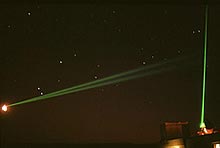Solid stops light

One laser can help halt another. <br>© SPL
A crystal that holds light could facilitate quantum computing.
Researchers in the United States and Korea have brought light to a complete standstill in a crystal. The pulse is effectively held within the solid, ready to be released at a later stage.
This trick could be used to store information in a quantum computer1.
Normal computers store information in simple binary form (1’s and 0’s) in electronic and magnetic devices. Stationary light pulses can encode information in more sophisticated ways that use the laws of quantum mechanics, making information processing more powerful.
Light moves at 186,000 miles per second through empty space, and was first stopped in its tracks at the beginning of last year. In that experiment, a vapour of metal atoms cooled close to absolute zero was shown to act like molasses on a passing light beam2,3.
Now Philip Hemmer, of the Air Force Research Laboratory at Hanscom Air Force Base in Massachusetts, and his colleagues have halted light in a crystal of yttrium silicate containing a few atoms of the element praseodymium.
Light-stopping solids would be much easier to incorporate into faster, more powerful computers than extremely cold gases. So the advance could aid information technology in much the same way that solid-state diodes and transistors made electronics more compact and robust than it could be with vacuum tubes.
Light slows down very slightly when it passes into any substance from a vacuum. The greater the refractive index of the material, the slower the light becomes. To make laser light travel very slowly, researchers create substances with immense refractive indices.
Hemmer’s team use a second laser beam to excite atoms in a substance to new energy states. Light can be considered to propagate through a material by being sequentially absorbed and re-emitted by atoms. The second beam manipulates this process so that it becomes more and more difficult for the light to make the step from one atom to the next.
The second beam couples the light pulse to the atoms. When shackled to these heavy objects, the pulse slows down. If this coupling is strong enough, the pulse comes to rest and all its energy is transferred to the atoms.
A light pulse that is brought to a standstill is not destroyed. The atoms ’remember’ it, so the pulse can be regenerated by changing the intensity of the coupling laser to allow the atoms to re-emit photons – the particles of which light is composed.
References
- Turukhin, A. V. et. al. Observation of ultraslow and stored light pulses in a solid. Physical Review Letters, 88, 023602, (2002).
- Liu, C., Dutton, Z., Behroozi, C. H. & Hau, L. V. Observation of coherent optical information storage in an atomic medium using halted light pulses. Physical Review Letters, 88, 023602, (2002).
- Phillips, D. F., Fleischhauer, A., Mair, A. & Walsworth, R. L. Storage of Light in Atomic Vapor. Nature, 409, 490 – 493, (2001).
Media Contact
More Information:
http://www.nature.com/nsu/020107/020107-2.htmlAll latest news from the category: Information Technology
Here you can find a summary of innovations in the fields of information and data processing and up-to-date developments on IT equipment and hardware.
This area covers topics such as IT services, IT architectures, IT management and telecommunications.
Newest articles

NASA: Mystery of life’s handedness deepens
The mystery of why life uses molecules with specific orientations has deepened with a NASA-funded discovery that RNA — a key molecule thought to have potentially held the instructions for…

What are the effects of historic lithium mining on water quality?
Study reveals low levels of common contaminants but high levels of other elements in waters associated with an abandoned lithium mine. Lithium ore and mining waste from a historic lithium…

Quantum-inspired design boosts efficiency of heat-to-electricity conversion
Rice engineers take unconventional route to improving thermophotovoltaic systems. Researchers at Rice University have found a new way to improve a key element of thermophotovoltaic (TPV) systems, which convert heat…



